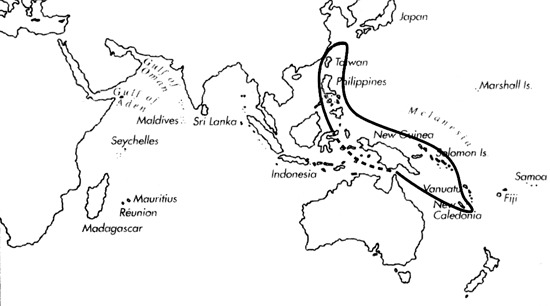Range: Okinawa to Papua New Guinea and New Caledonia.
Description: Small to moderately small, light. Last whorl conical to ventricosely conical; outline convex at adapical third, straight below. Shoulder angulate to subangulate. Spire of moderate height, outline straight to domed. Larval shell of 3- 3.5 whorls, maximum diameter 0.8-0.9 mm. Teleoconch sutural ramps flat to slightly convex, with 0-3 increasing to 4-7 fine spiral grooves, inconspicuous on latest ramps. Last whorl with spiral ribs at base.
| Shell Morphometry | ||
|---|---|---|
| L | 15-30 mm | |
| RW | 0.02-0.06 g/mm | |
| (L 19-29 mm) | ||
| RD | 0.52-0.61 | |
| PMD | 0.81-0.93 | |
| RSH | 0.17-0.23 | |
Ground colour pale grey to pink. Last whorl with orange to pink, sometimes olive-brown to dark brown clouds and streaks, usually leaving a maculated light spiral band at centre; usually interrupted spiral ground-colour zones at base and centre. Often spiral rows of dark dashes or dots extending from base to shoulder. Larval whorls orange to pink. Postnuclear sutural ramps with darker radial lines and blotches. Aperture violet, with exterior pattern shining through.
Periostracum thin and translucent, sometimes with widely spaced spiral rows of fine tufts.
Animal coral red, dotted with white (E. New Britain; Richards, 1989). Chaberman's animal description of "C. luteus Sowerby" (pers. comm., 1981) seems to refer to this species: Dorsum of foot pink, darker marginally and grading to red at anterior end, with a brown spot beneath the operculum. Sole of foot pale pink. Siphon bright red, dotted with tan and white.
Habitat and Habits: In 6-240 m, associated with corals, sponges and sea-weed and among coral rubble.
Discussion: C. corallinus is sometimes misidentified as C. dilectus (see C. textile) and C. luteus, or considered a juvenile of C. pertusus. Although C. luteus is sometimes similar in colouration, it is a considerably larger species (to 45 mm) with a narrower last whorl (RD 0.42-0.53). C. viola (incl. form blatteus) also differs from C. corallinus in being larger (to 48 mm), having a narrower (RD 0.43-0.51) and more cylindrical last whorl; its shoulder is subangulate to rounded and its late postnuclear whorls are distinclty stepped. For the differences between C. corallinus and C. pertusus, C. granum and C.nucleus, see the DISCUSSIONS of those species.

C. corallinus range map
This section contains verbatim reproductions of the accounts of 316 species of Conus from the Indo-Pacific region, from Manual of the Living Conidae, by Röckel, Korn and Kohn (1995). They are reproduced with the kind permission of the present publisher, Conchbooks.
All plates and figures referred to in the text are also in Röckel, Korn & Kohn, 1995. Manual of the Living Conidae Vol. 1: Indo-Pacific Region.
The range maps have been modified so that each species account has it own map, rather than one map that showed the ranges of several species in the original work. This was necessary because each species account is on a separate page on the website and not confined to the order of accounts in the book.